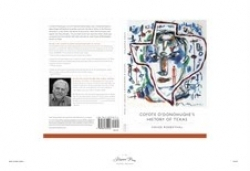Coyote O'Donohughe's History of Texas
Like any pivotal battle, the story of the Alamo has been relentlessly retold by countless authors. The Battle of the Alamo also appears in the latter half of Chuck Rosenthal’s new novel, Coyote O’Donohughe’s History of Texas, but readers will find a telling that is quite different than what has gone before. Through a fictional character, Rosenthal manages to cast a new light on American lore and its important figures.
Coyote follows the exciting adventures of “half-breed” Coyote O’Donohughe in the early 19th century. Raised from infancy by his Comanche mother’s tribe, Coyote is later also endowed with a classical western education by the intervention of his Spanish father. As a result, he is thoroughly acclimated to the equine-centric Plains Indian lifestyle of mysticism and polytheism, and also fully versed in western culture and history. Ergo, Coyote straddles the cultural divide between so-called wild and civilized societies, while keeping his loyalties mainly with the Comanche. When whites decide to attack the Comanche to catch the Coyote for certain misdeeds against rangers, he is forced to wander the country. While he does, he is able to observe historic events from an original perspective.
While not revising the course or cause of historic events, Rosenthal, through Coyote, lends the well-known individuals involved (Crocket, Bowie, Houston, and Santa Ana, to name a few) more personality, more humanity, and more fallibility than is commonly attributed to them. The result is a humorous and often black episodic narrative that addresses the very real events of a time in which indigenous people were being driven off the face of North America, and Mexico and Texas were battling for primacy.
Beginning with a darkly funny village raid on a neighboring village, Coyote is steeped in almost matter-of-fact violence. In the opening scene, the young hero is found using the detruncated head of a tribeswoman on his spear as a decoy to confuse an attacking ranger. More such scenes will follow, although this one is perhaps the grittiest.
Illuminating the humor in history is only one of the book’s achievements. Coyote also succeeds in making both beautiful and human a people who too often go unrepresented in history. Coyote is a tragedy, given the ultimate near-extinction of the American Indian population, yet readers may find themselves finishing the book with a more realistic vision of this period in American development.
An entertaining read, Coyote will have readers reaching for their history books to learn more.
Reviewed by
Leia Menlove
Disclosure: This article is not an endorsement, but a review. The publisher of this book provided free copies of the book and paid a small fee to have their book reviewed by a professional reviewer. Foreword Reviews and Clarion Reviews make no guarantee that the publisher will receive a positive review. Foreword Magazine, Inc. is disclosing this in accordance with the Federal Trade Commission’s 16 CFR, Part 255.

